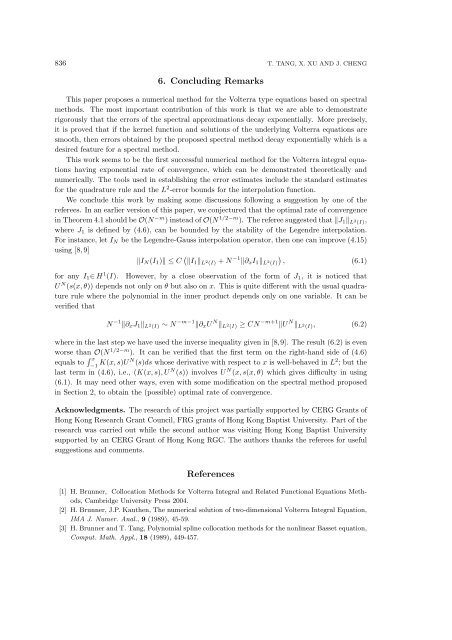On Spectral Methods for Volterra Type Integral Equations and the ...
On Spectral Methods for Volterra Type Integral Equations and the ...
On Spectral Methods for Volterra Type Integral Equations and the ...
You also want an ePaper? Increase the reach of your titles
YUMPU automatically turns print PDFs into web optimized ePapers that Google loves.
836 T. TANG, X. XU AND J. CHENG<br />
6. Concluding Remarks<br />
This paper proposes a numerical method <strong>for</strong> <strong>the</strong> <strong>Volterra</strong> type equations based on spectral<br />
methods. The most important contribution of this work is that we are able to demonstrate<br />
rigorously that <strong>the</strong> errors of <strong>the</strong> spectral approximations decay exponentially. More precisely,<br />
it is proved that if <strong>the</strong> kernel function <strong>and</strong> solutions of <strong>the</strong> underlying <strong>Volterra</strong> equations are<br />
smooth, <strong>the</strong>n errors obtained by <strong>the</strong> proposed spectral method decay exponentially which is a<br />
desired feature <strong>for</strong> a spectral method.<br />
This work seems to be <strong>the</strong> first successful numerical method <strong>for</strong> <strong>the</strong> <strong>Volterra</strong> integral equations<br />
having exponential rate of convergence, which can be demonstrated <strong>the</strong>oretically <strong>and</strong><br />
numerically. The tools used in establishing <strong>the</strong> error estimates include <strong>the</strong> st<strong>and</strong>ard estimates<br />
<strong>for</strong> <strong>the</strong> quadrature rule <strong>and</strong> <strong>the</strong> L 2 -error bounds <strong>for</strong> <strong>the</strong> interpolation function.<br />
We conclude this work by making some discussions following a suggestion by one of <strong>the</strong><br />
referees. In an earlier version of this paper, we conjectured that <strong>the</strong> optimal rate of convergence<br />
in Theorem 4.1 should be O(N −m ) instead of O(N 1/2−m ). The referee suggested that ‖J 1 ‖ L2 (I),<br />
where J 1 is defined by (4.6), can be bounded by <strong>the</strong> stability of <strong>the</strong> Legendre interpolation.<br />
For instance, let I N be <strong>the</strong> Legendre-Gauss interpolation operator, <strong>the</strong>n one can improve (4.15)<br />
using [8,9]<br />
‖I N (I 1 )‖ ≤ C ( ‖I 1 ‖ L2 (I) + N −1 ‖∂ x I 1 ‖ L2 (I))<br />
, (6.1)<br />
<strong>for</strong> any I 1 ∈H 1 (I). However, by a close observation of <strong>the</strong> <strong>for</strong>m of J 1 , it is noticed that<br />
U N (s(x, θ)) depends not only on θ but also on x. This is quite different with <strong>the</strong> usual quadrature<br />
rule where <strong>the</strong> polynomial in <strong>the</strong> inner product depends only on one variable. It can be<br />
verified that<br />
N −1 ‖∂ x J 1 ‖ L2 (I) ∼ N −m−1 ‖∂ x U N ‖ L2 (I) ≥ CN −m+1 ‖U N ‖ L2 (I), (6.2)<br />
where in <strong>the</strong> last step we have used <strong>the</strong> inverse inequality given in [8,9]. The result (6.2) is even<br />
worse than O(N 1/2−m ). It can be verified that <strong>the</strong> first term on <strong>the</strong> right-h<strong>and</strong> side of (4.6)<br />
equals to ∫ x<br />
−1 K(x, s)UN (s)ds whose derivative with respect to x is well-behaved in L 2 ; but <strong>the</strong><br />
last term in (4.6), i.e., (K(x, s), U N (s)) involves U N (x, s(x, θ) which gives difficulty in using<br />
(6.1). It may need o<strong>the</strong>r ways, even with some modification on <strong>the</strong> spectral method proposed<br />
in Section 2, to obtain <strong>the</strong> (possible) optimal rate of convergence.<br />
Acknowledgments. The research of this project was partially supported by CERG Grants of<br />
Hong Kong Research Grant Council, FRG grants of Hong Kong Baptist University. Part of <strong>the</strong><br />
research was carried out while <strong>the</strong> second author was visiting Hong Kong Baptist University<br />
supported by an CERG Grant of Hong Kong RGC. The authors thanks <strong>the</strong> referees <strong>for</strong> useful<br />
suggestions <strong>and</strong> comments.<br />
References<br />
[1] H. Brunner, Collocation <strong>Methods</strong> <strong>for</strong> <strong>Volterra</strong> <strong>Integral</strong> <strong>and</strong> Related Functional <strong>Equations</strong> <strong>Methods</strong>,<br />
Cambridge University Press 2004.<br />
[2] H. Brunner, J.P. Kau<strong>the</strong>n, The numerical solution of two-dimensional <strong>Volterra</strong> <strong>Integral</strong> Equation,<br />
IMA J. Numer. Anal., 9 (1989), 45-59.<br />
[3] H. Brunner <strong>and</strong> T. Tang, Polynomial spline collocation methods <strong>for</strong> <strong>the</strong> nonlinear Basset equation,<br />
Comput. Math. Appl., 18 (1989), 449-457.

















